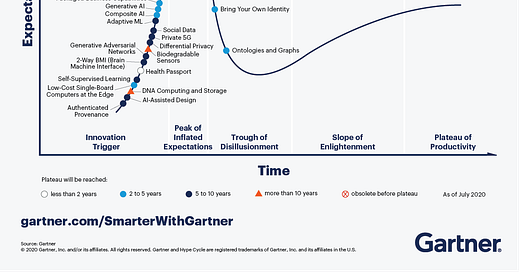
Salam everyone!
Growing Meta officially goes to more than 100 knowledge lovers. Thank you!
I love reading the scientific literature (sometimes, more than reading books). It’s always the latest thought, you can access criticism immediately in citing articles, and you can learn a lot in a few pages (unlike some books that have a lot of fluff).
Reading is an investment, and time is the cost. We need to think like investors when we choose what we read.
This week, I thought a lot about the growing trend of digital personal knowledge management (PKM). I couldn’t help but wonder if it’s going to have a decline in the future. We all are familiar with Garter’s Hype Cycle. Consultants were the first to study hype up-close; they analyze many different technologies along the years by looking at expectations, eventually it helps them with strategic investment decisions.

But, is that the only shape of hype? and where does Personal Knowledge Management (PKM) stand in the curve?
Here’s a paper that tries to coin the factors behind tech hype.
Comparing technological hype cycles: Towards a theory (2013)
Harro van Lente, Charlotte Spitters, Alexander Peine
Hype is how much everyone is expecting from certain tech. There is always a peak, a trough and a recovery. Some cycles take decades, others are rather short.

Expectations affect the emergence of tech. It guides research activities, attracts resources and creates legitimacy. Everyone will flock if there is social proof. But let’s step back to understand what hype means to everyone.
First off, hype means something different based on who you are.
To marketers, it’s a wave.
To researchers, it’s potential money.
To investors, it’s legitimacy (or a risk).
To businessfolk, it’s a hit or miss decision.
And in academic speak: “hype is a collectively shared rhetoric about an emerging technology and the underlying innovative activities.”
Surely every tech is different.
So what are the different shapes of hype?
The authors look back at the history of 3 different technologies (Voice over IP, Gene therapy and High temperature Superconductivity). They assert that the patterns are very different, there is not shape that fits all.

They list three variables that determine the hype curve:
shape of the peak,
depth of the trough,
overall length of the hype.
Hype curves rely on two dimensions:
1- How specific is the application area.
The more specificity, the less expectation rises after the trough.
2- How the environment looks like
Funding, regulations, business potential — stuff like that influence how expectations rise after the trough.
So how can we assess Personal Knowledge Management (PKM) against hype curves?
Everyone is expecting a lot from personal information organizing apps. Anne-Laure of Ness Labs did a well rounded report on the State of PKM Tools. She covers 120+ tools that help with everything from note-capturing to visual thinking. Now, we have many hyped up communities that take note taking as a religion (*cough* roamcult *cough*). There are courses dedicated for PKM (e.g. Building a Second Brain). I think the hype just started climbing the mountain. But how big is the mountain?
The tech was around for more than a decade, but only now is the trend rising. I think it’s a result of several things, but mainly: rise of the individual creator (read this article by Jon Hillis on the six economies of online creators) and the abundance of information.
Personally, I think that there are many pain points in PKM that still needs to be solved. But because PKM isn’t for everyone (but everyone hasn’t realized that yet), it will receive a counter attack sometime in the future. I also feel that the cycle will take 10-20 years. After that I think it will be broken by accessible AI that has really good information extraction and synthesis capacity, and can sort through what info you need in seconds.
Would love to hear your thoughts: is the PKM hype falling anytime soon?


